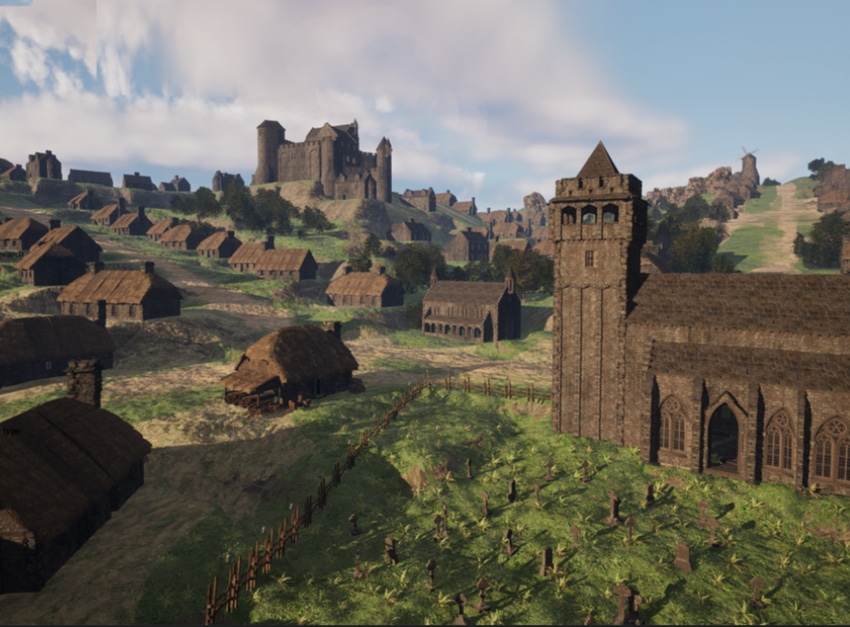To what Extent can Architectural Constructs act as a Foundation for the Procedural Generation of Medieval Villages.
To what extent can architectural constructs act as a foundation for procedurally generated medieval villages?

To what extent can architectural constructs act as a foundation for procedurally generated medieval villages?
Architectural Constructs
In Architecture, the patterns are used to create functional and aesthetically pleasing structures. They encompass a range of spatial arrangements, forms, and features that contribute to the overall design of buildings and environments. These constructs guide designers in making informed decisions about layout, proportions, materials, and other design aspects, ensuring coherence, functionality, and visual harmony. In the context of game design, architectural constructs can be applied to virtual spaces to enhance the believability, immersion, and overall quality of the game environment.
Examples of the architectural patterns that are primarily used are the patterns of the high places and the pattern of the activity node.
The pattern of the high places describes how the elevated points offer commanding views and serve as focal points, drawing attention and creating a sense of importance. Besides that, valleys are more suited for agriculture, therefore should the houses be constructed more on the hills.
The pattern of the activity node describes how places in the middle of settlements should be reserved for encouraging social interactions and engagements.
The research process
The research involved two groups of experienced industry-level designers who were given a procedural village generator developed specifically for this study. These two groups are called called for the purpose of this research creators. Both groups were tasked with creating a medieval village for a role-playing game setting. One group received support from architectural patterns, while the other relied solely on their personal experience and knowledge during the creation process. Subsequently, a separate group of participants, who are called for the purpose of this research spectators, conducted a comparison between the two scenes, evaluating characteristics such as layout and structure, aesthetics, and variety. Based on the quantitative and qualitative data excluded from the questionnaires that they filled in, a conclusion can be drawn.
Pipeline of The Tool
The procedural creation of a village within Unreal Engine encompasses a series of steps. It begins with the establishment of city boundaries and envisioning the village's size. Once settled, significant points within the village are placed, serving as focal points and hotspots for the road network. These primary features, such as a central church in this instance, lay the foundation for the village layout.(1)
Following this, zones are defined to influence the districts of the city. These zones play a pivotal role in shaping the visual structure of the cityscape, determining building placements and road patterns.(2)
The process then moves to crafting the road system, which is adaptable due to the utilization of adjustable splines. These splines allow for easy transformations, ensuring the creation of desired city shapes.(3)
Once the road system is established, the landscape is adjusted to align with the roads. Houses are then generated in relation to the road layout, with each house's identity tied to the characteristics of its corresponding district. (4)
Vegetation and foliage are introduced next, either along the roads, within adjustable volumes, or along custom splines. Small props are scattered throughout the scene, enhancing its visual appeal. These props are positioned according to spawn markers, which dictate their placement. This process also encompasses the addition of points of interest, spline props, and prefabricated structures, offering diverse elements to the scene.(5)
In case certain areas are generated less satisfactorily, the method offers the flexibility to employ volumes for targeted content deletion or addition without necessitating an entire regeneration. This non-destructive approach allows for fine-tuning and adjustments to specific portions of the village.
Conclusion
This study focused on exploring the impact of architectural patterns on the procedural generation of medieval villages. The primary objective was to understand how these patterns influence the outcomes of procedural generation and whether they enhance the efforts of level designers. By administering a comparative questionnaire and analyzing interview data, the research aimed to discern any significant differences in the quality and appeal of the generated villages.
The outcomes of the comparison test demonstrated that the scenes created with architectural patterns provided a more captivating and engaging atmosphere, radiating a sense of realism and authenticity befitting the medieval theme. However, no significant differences were found in terms of layout and overall structure. This could be attributed to the capabilities of the procedural tool in terms of generating these aspects. This can be derived from the valuable feedback provided by the creators who utilized the tool. The tool was characterized as robust, particularly in terms of constructing structures, with a special emphasis on the road network. The concept of flow was a recurring theme in discussions. This flow facilitated a flexible workflow that prioritized swift iterations of village designs, contributing to the substantial generation of content. Consequently, a satisfactory level of diversity in road structures emerged, resulting in minimal discernible discrepancies in layout between villages created with or without the implemented information of the patterns.
The analysis of data obtained from the comparison questionnaire suggests a conclusive finding: the incorporation of architectural patterns and associated information can yield advantageous outcomes in the development of medieval villages, particularly when the objective is to craft scenes that evoke a sense of authenticity, captivation, and aesthetic appeal. This approach is notably conducive to scenes necessitating realism. By adopting such an approach, there is a potential for heightened efficiency and guidance of creativity in the level design pipeline.
A link to the full project can be found here.
https://github.com/JasperMoens/VillageGenerator.git
Read more about:
BlogsAbout the Author(s)
You May Also Like













